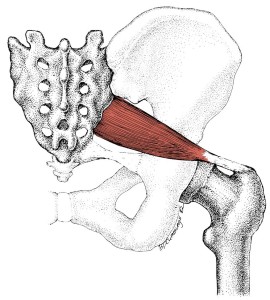 The piriformis muscle connects the legs to the spine at the back of the body and if you think of someone getting out of a car and lifting the first leg out, that is the work of the piriformis. This muscle is chronically tight for many people and is the cause of the condition known as piriformis syndrome where the piriformis muscle in spasm presses on the sciatic nerve.
The piriformis muscle connects the legs to the spine at the back of the body and if you think of someone getting out of a car and lifting the first leg out, that is the work of the piriformis. This muscle is chronically tight for many people and is the cause of the condition known as piriformis syndrome where the piriformis muscle in spasm presses on the sciatic nerve.
If you do yoga and you are familiar with pigeon pose, the stretch you feel deep in the butt of the forward leg is the piriformis. If you don’t know from yoga and are sitting at your desk, cross one ankle over the other knee and try to extend forward with a neutral spine—that is a piriformis stretch.
The piriformis muscle turns out the foot by externally rotating a straight leg and slightly abducting (pull away) a leg when the knee bends. It does this by engaging and contracting in order to turn the leg open. When we stand in anatomical neutral with the feet relatively close together and parallel, the piriformis aligns correctly because the placement of the feet and lower leg determine how the femur bone of the upper leg sits in the hip socket. When the piriformis muscle is aligned correctly it is free to then turn the feet out when called upon to do so.
What if, instead of your feet being parallel and then turning open, your feet were always turned open? This is the sorry state of so much of the world’s population. We all live with our feet turned out to one degree or another. This means that the piriformis is always in a shortened state. And to return to the image of pigeon pose and/or crossing your ankle over your knee, if you relate to the idea of a tight piriformis muscle that restricts movement forward, that tightness in the muscle likely relates to your habitual turnout.
To add the inevitable caveat—it is just as likely that turning out your feet habitually means you might have a loose and weak piriformis. This type of person, though in the minority, feels nothing with the aforementioned butt stretches.
Most people walk and stand with the feet turned out and a piriformis muscle that rarely gets to function correctly. Changing movement patterns and learning to stand and exercise correctly would be a gift to your ill-treated piriformis muscle.
